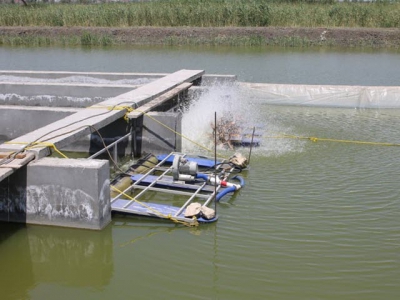Aquaculture in action: in-pond innovation doubles tilapia production in Egyptian trials

In the face of rising production costs and limited land and water availability, Egyptian fish farmers are looking for new ways to achieve higher productivity and profitability
In-pond raceway model established for the first time in Egypt at Abbassa Research Center run by WorldFish, in cooperation with the USSEC, under the SDC- funded STREAMS project. Photo © Sara Fouad
The in-pond raceway system (IPRS) cultures fish in raceways in existing pond units. Solid waste is removed, conserving water quality for reuse. Developed at Auburn University in Alabama, United States, the system has been used for the production of channel catfish in the US and grass carp in China.
This is the first time it has been tested for tilapia production in Egypt, as part of the Sustainable Transformation of Egypt’s Aquaculture Market System project. The project is led by WorldFish, an international non-profit research organisation based in Malaysia, and is being implemented in collaboration with the US Soybean Export Council, which provides the feed.
To create the raceways, three concrete cells were constructed in a 1 feddan (approximately 4,000sq m) pond at the Africa Aquaculture Research and Training Center in Abbassa, outside Cairo. The cells were equipped with pumps for continuous water movement and aeration during the production season and stocked with a fast-growing Nile tilapia strain developed by WorldFish.

Construction of the In-pond raceway system at Abbassa Research Center, Abu-Hammad, Sharkia, Egypt
“The water current carries fish waste through a screen at the end of the raceways into a ‘quiescent zone’,” explained Dr Ahmed Nasr-Allah, a scientist at WorldFish. “Waste settles in the quiescent zone before being removed by a suction pump for use as a crop fertiliser. The water then moves to the open area of the pond where it is recharged with oxygen and returned to the raceway. No water is discharged, other than to periodically replace seepage and evaporation losses.”
Innovation in intensified production
The IPRS was selected for testing in Egypt as a means to meet the increasing demand for aquaculture products in the country while addressing mounting economic and environmental constraints.
“The technology addresses these constraints by allowing maximum use of available water resources and greater production at lower per-unit cost through higher fish survival and feed conversion,” said Dr Harrison Karisa, WorldFish’s country director for Egypt and Nigeria. “The zero water exchange – or closed – system also improves biosecurity measures, thus minimising disease risks and the need to apply drugs and chemicals.”
Results from the test showed that the system can produce 10-12 metric tonnes of tilapia from a 1 feddan pond, compared with a regular earthen pond that produces 4-5 metric tonnes. This is more than double the production within four months.

In-pond raceway culture system model implemented under the STREAMS project. Photo © Sarah Fouad
“The system has the potential to revolutionise the way aquaculture is done in Egypt. This could pave the way for further innovations in intensified production of farmed fish while allowing for a significant reduction in the use of extra nitrogenous fertiliser in low-input cropping systems here and elsewhere on the African continent,” said Karisa.
A further trial carried out to produce a low-cost unit using lining material and wood reduced the construction costs by up to half compared to the concrete cells.
Có thể bạn quan tâm
Phần mềm

Phối trộn thức ăn chăn nuôi

Pha dung dịch thủy canh

Định mức cho tôm ăn

Phối trộn phân bón NPK

Xác định tỷ lệ tôm sống

Chuyển đổi đơn vị phân bón

Xác định công suất sục khí

Chuyển đổi đơn vị tôm

Tính diện tích nhà kính

Tính thể tích ao hồ




 Infection with Infectious Spleen and Kidney Necrosis Virus…
Infection with Infectious Spleen and Kidney Necrosis Virus…  Probiotics to boost immune fitness and gut health
Probiotics to boost immune fitness and gut health